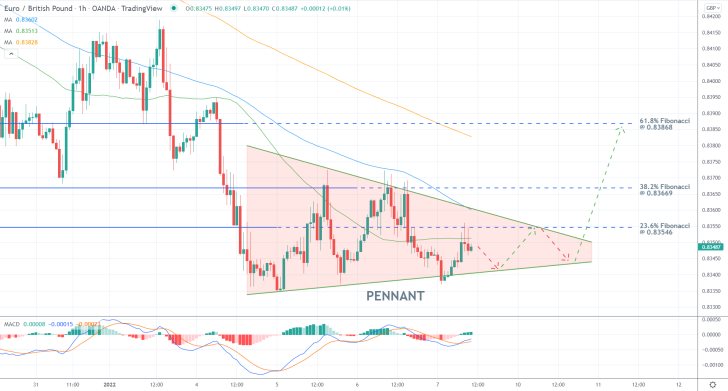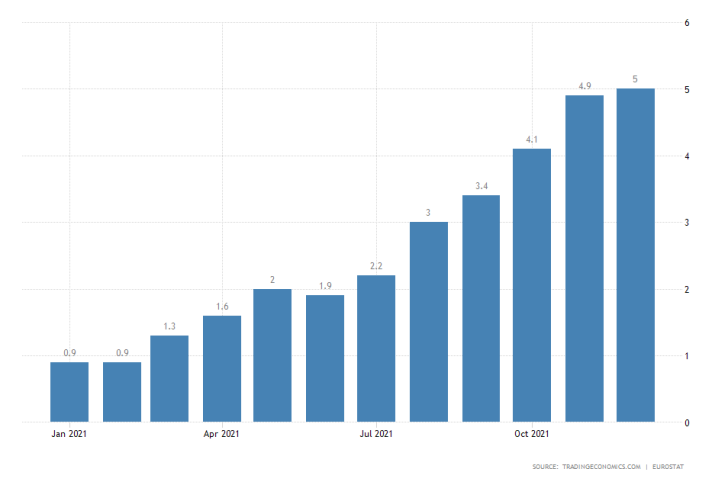
The euro strengthened against most other currencies following the release of the latest CPI report by Eurostat measuring headline inflation in the Eurozone. Have a look at our latest EURUSD analysis to get a better sense of where the single currency is headed next.
Inflation in the Eurozone accelerated for the sixth consecutive month in December, beating the market forecasts which were anticipating a moderate decline. Consumer prices advanced parallel to an upsurge of consumption in the Euro Area over the same period, bolstered by rising energy prices.

Despite the temporary strengthening of the euro inspired by the CPI data, the single currency continues to consolidate against the pound, as shown on the hourly chart above.
The consolidation is taking the form of a major Pennant pattern at the dip of the preceding downtrend. This could be a precursor to a major trend reversal currently in the making. The MACD indicator is elucidating a moderate increase of bullish momentum, though the underlying market bias remains mostly neutral.
The price action would have to break out above the 50-day MA (in green) and 100-day MA (in blue) before a new uptrend can begin developing. The two moving averages are currently threading near the upper limit of the Pennant, which is converging with the 23.6 per cent Fibonacci retracement level at 0.83546.
If such a decisive breakout does occur, it would most likely head towards the 61.8 per cent Fibonacci at 0.83868 next. Before the price action could climb so high, however, it would have to penetrate above the 200-day MA (in orange).
Inflation in the Eurozone continues to rise unimpeded

According to the findings of Eurostat, headline inflation in the bloc reached 5 per cent in December, the highest level on record. This measures a marginal increase of 0.1 per cent from a month prior. The consensus forecasts were instead anticipating a moderate contraction to 4.8 per cent.
The accelerating inflation underpins the latest fears of the European Central Bank (ECB), which accordingly decided to adopt a more hawkish stance during its last meeting in a bid to curb further jumps in consumer prices.
Trendsharks Premium
Gold is undergoing a correction, as investors take profits to offset losses from falling stock prices, impacting their margins. However, we anticipate a renewed wave of [...]
The Swiss stock market index is mirroring its global counterparts, such as Germany 40 and US100, experiencing a sharp decline following the announcement of new [...]
We’re analyzing the weekly chart to grasp the broader market trend. Over the past three years, the US30 index has surged by 17,000 points, often resembling a nearly straight [...]
Over the past week, the DAX has experienced a sharp decline, plunging by an astonishing 3,400 points. This downward movement is not isolated, as its international counterparts, such as the UK100 and US100, are also facing significant [...]
EURUSD recently formed a double top at 1.0930, signaling a potential trend reversal, and has since begun a correction. After a 600-pip rally since early March, a pullback at this stage is both expected and healthy. Given these conditions, we are placing a [...]
Since early March, EURJPY has surged nearly 1,000 pips, providing us with several excellent trading opportunities. However, as the rally matures, many early buyers are beginning to take profits, leading to a noticeable slowdown in the uptrend. On Friday, the pair formed a [...]
The AUDJPY currency pair continues to be dominated by bullish momentum, as multiple golden cross patterns reaffirm the strength of the ongoing uptrend. Despite this, we are witnessing a much-needed [...]
The EURAUD currency pair appears to be undergoing a trend reversal, signaling a potential shift in market direction. A notable technical development is the formation of a Death Cross on the chart, a widely recognized bearish indicator that typically suggests a [...]
After securing an impressive 200-pip profit last week, the EURJPY currency pair is now undergoing a southward correction, retracing some of its recent gains. Despite this temporary pullback, the Golden Cross remains intact, reinforcing our view that the overall trend continues to be [...]
The appearance of a Golden Cross in Silver strengthens our analysis that the metal is currently in a strong uptrend, indicating further bullish momentum in the market. This technical pattern, where the short-term moving average crosses above the [...]
This trade presents a considerable level of risk and can be classified as an opportunistic move based on recent price action. The GBPUSD currency pair has experienced a substantial bullish rally, surging by nearly 500 pips in a strong upward movement. However, after this extended period of appreciation, the pair is showing signs of a potential [...]
The anticipated Death Cross on the SMI20 appears to be failing as price finds strong support at the 23% Fibonacci retracement level. After testing this area, the index has shown bullish strength, printing several large green candles, signaling an increase in [...]
A Golden Cross has just appeared on the USDJPY chart, signaling a potential bullish move. This technical pattern occurs when the 20 period moving average crosses above the 60 period moving average, a widely recognized indication of increasing [...]
After 2 months of a down trend, we finally see some indications of price recovery for Oil. The golden cross, a historic buy signal, supports this [...]
For the past month, the German DAX40 has experienced a remarkable 10% surge, reflecting strong bullish momentum. Despite ongoing market volatility and frequent pullbacks, every dip continues to attract fresh buyers, reinforcing the [...]
Oil continues its downward trajectory, despite occasional pullbacks. The overall trend remains bearish, reinforced by multiple Death Cross patterns, a classic sell signal indicating further weakness. Adding to this bearish outlook, the critical [...]
Over the past few days, gold has experienced a sharp decline of more than $100. This downturn can be attributed in part to traders securing profits to manage their margins, which are under strain due to the significant drop in major indices. Currently, gold has fallen below the [...]
The NASDAQ 100 index is showing strong bullish momentum, as evidenced by the formation of a Golden Cross on the chart. This classic buy signal occurs when the short moving average crosses above the long term moving average, suggesting that upward momentum is [...]
The EURAUD currency pair has encountered a significant resistance level, failing to break above the critical 61% Fibonacci retracement level. This suggests that bullish momentum is weakening, reinforcing the case for a potential downward move. Given this technical setup, we favor entering a [...]
The UK100 is experiencing a remarkable rally! Over the past few weeks, the British stock market index has surged nearly 800 points. Each minor dip has attracted more buyers, fueling the bullish momentum. However, since last week, we’ve observed a slight [...]




















